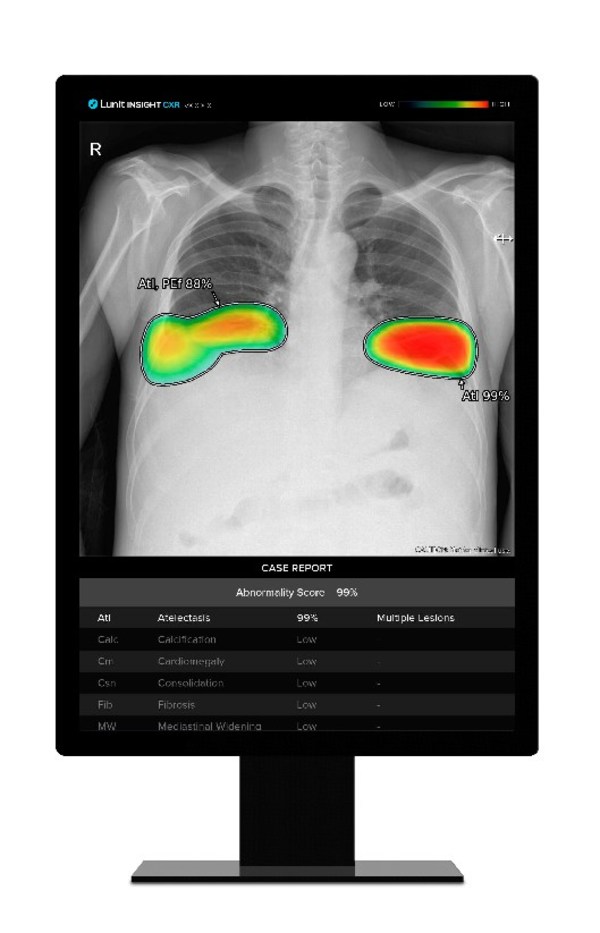Lunit AI Can Help Tuberculosis Screening in Prisons, as Published in The Lancet Regional Health - Americas
ByPublished : Dec. 16, 2022 - 00:10

- Recent study suggests that AI-based x-ray interpretation algorithms may be an efficient means to improve TB case detection among incarcerated populations
- Lunit INSIGHT CXR showed the most superior performance among the tested cohort, with greater accuracy and generalizability among subgroups
SEOUL, South Korea, Dec. 15, 2022 /PRNewswire/ -- Findings from a recent study published in the January 2023 issue of The Lancet Regional Health – Americas[1] demonstrate the effectiveness of Lunit INSIGHT CXR as a triage tool for tuberculosis (TB) screening in prisons.
Globally, prisons are high-risk settings for TB. In South America, TB cases in prisons have more than doubled since 2000 amid rising incarceration rates. To address this growing burden, the World Health Organization (WHO) released updated guidelines[2] in 2021 to recommend Lunit INSIGHT CXR as one of the computer-aided detection (CAD) software that can be used in place of human readers for TB screening. Lunit INSIGHT CXR detects suspicious lesions in chest x-ray images, helping radiologists distinguish disease areas by providing the location of the lesion with an abnormality score that reflects the AI's confidence level. The AI solution can detect 10 of the most common chest abnormalities, including tuberculosis, with 97-99% accuracy.[3]
A study was conducted by an international team led by Dr. Julio Croda, Ph.D., of the Federal University of Mato Grosso do Sul in Brazil to assess the accuracy of AI-based chest x-ray interpretation algorithms for TB screening in prisons. Researchers performed prospective TB screening in three male prisons in Brazil from October 2017 to December 2019. All individuals underwent portable chest x-ray exams, with sputum collected to confirm TB by lab tests. The x-ray images were evaluated using three commercially available x-ray algorithms, including Lunit INSIGHT CXR.
Among 2,075 incarcerated individuals, 259 (12.5%) had confirmed TB. While all three algorithms performed similarly overall with areas under the receiver operating characteristic curve (AUROC) of 0.88 to 0.91, Lunit INSIGHT CXR was among the only two algorithms that met WHO requirements for a triage test. Researchers noted Lunit INSIGHT CXR to be the best-performing algorithm among the cohort, showing greater accuracy and generalizability among subgroups, with particularly superior robustness to age compared to the other two algorithms. Furthermore, Lunit INSIGHT CXR was the only algorithm that met the WHO's target product profile (TPP) criteria among individuals 45 years and older.
Ultimately, TB screening by chest x-rays with AI-based interpretation algorithms, followed by confirmatory testing using molecular diagnostics, may be an efficient means to improve case detection among incarcerated populations, the authors suggested.
"The use of computer-aided detection (CAD) software is practical and inexpensive in the prison environment. CAD is accurate for mass screening in populations with a high TB burden," explained Dr. Julio Croda. "We observed a decrease in CAD specificity only in people who had already had tuberculosis. In this specific group, it is important to be cautious and perform microbiological screening before any clinical decision."
"This is a meaningful study that shows the value Lunit INSIGHT CXR can bring to environments like prisons which are highly vulnerable to tuberculosis yet lacking diagnostic specialists," said Brandon Suh, CEO of Lunit. "We hope that this study will provide the means to facilitate new cost-effective screening programs utilizing AI-based solutions."
The Lancet Regional Health – Americas is an open-access journal launched in 2021 as part of The Lancet's global initiative to advocate for healthcare quality and access in all regions of the world. The Lancet is an international peer-reviewed general medical journal and the world's highest-impact academic journal (impact factor: 202.7).
[1] https://doi.org/10.1016/j.lana.2022.100388






![[Exclusive] Hyundai Mobis eyes closer ties with BYD](http://res.heraldm.com/phpwas/restmb_idxmake.php?idx=644&simg=/content/image/2024/11/25/20241125050044_0.jpg&u=)
![[Herald Review] 'Gangnam B-Side' combines social realism with masterful suspense, performance](http://res.heraldm.com/phpwas/restmb_idxmake.php?idx=644&simg=/content/image/2024/11/25/20241125050072_0.jpg&u=)

![[Herald Interview] 'Trump will use tariffs as first line of defense for American manufacturing'](http://res.heraldm.com/phpwas/restmb_idxmake.php?idx=644&simg=/content/image/2024/11/26/20241126050017_0.jpg&u=20241126161719)








![[Today’s K-pop] BTS’ Jin single hits Billboard’s Hot 100 at No. 53](http://res.heraldm.com/phpwas/restmb_idxmake.php?idx=642&simg=/content/image/2024/11/26/20241126050076_0.jpg&u=)